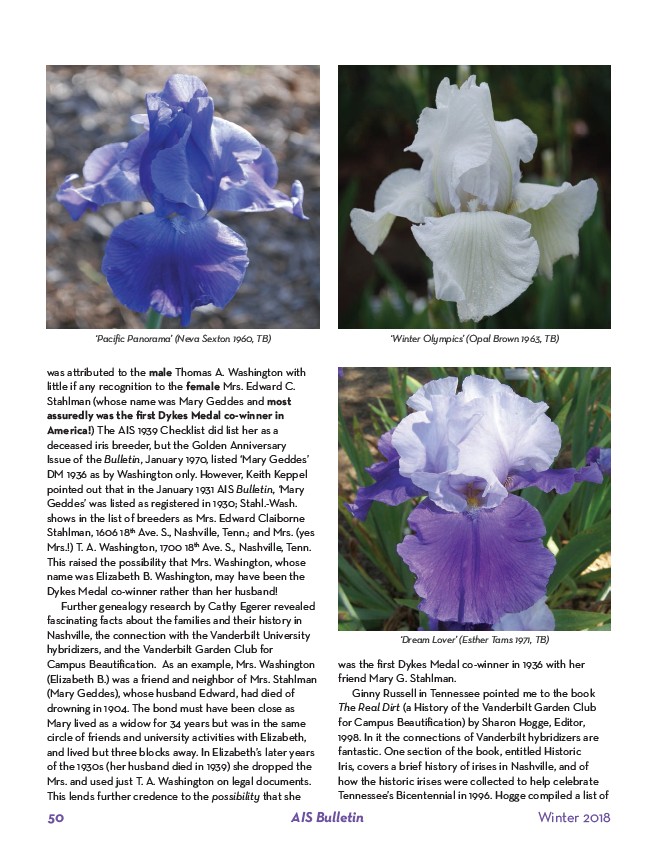
‘Pacific Panorama’ (Neva Sexton 1960, TB) ‘Winter Olympics’ (Opal Brown 1963, TB)
was attributed to the male Thomas A. Washington with
little if any recognition to the female Mrs. Edward C.
Stahlman (whose name was Mary Geddes and most
assuredly was the first Dykes Medal co-winner in
America!) The AIS 1939 Checklist did list her as a
deceased iris breeder, but the Golden Anniversary
Issue of the Bulletin, January 1970, listed ‘Mary Geddes’
DM 1936 as by Washington only. However, Keith Keppel
pointed out that in the January 1931 AIS Bulletin, ‘Mary
Geddes’ was listed as registered in 1930; Stahl.-Wash.
shows in the list of breeders as Mrs. Edward Claiborne
Stahlman, 1606 18th Ave. S., Nashville, Tenn.; and Mrs. (yes
Mrs.!) T. A. Washington, 1700 18th Ave. S., Nashville, Tenn.
This raised the possibility that Mrs. Washington, whose
name was Elizabeth B. Washington, may have been the
Dykes Medal co-winner rather than her husband!
Further genealogy research by Cathy Egerer revealed
fascinating facts about the families and their history in
Nashville, the connection with the Vanderbilt University
hybridizers, and the Vanderbilt Garden Club for
Campus Beautification. As an example, Mrs. Washington
(Elizabeth B.) was a friend and neighbor of Mrs. Stahlman
(Mary Geddes), whose husband Edward, had died of
drowning in 1904. The bond must have been close as
Mary lived as a widow for 34 years but was in the same
circle of friends and university activities with Elizabeth,
and lived but three blocks away. In Elizabeth’s later years
of the 1930s (her husband died in 1939) she dropped the
Mrs. and used just T. A. Washington on legal documents.
This lends further credence to the possibility that she
‘Dream Lover’ (Esther Tams 1971, TB)
was the first Dykes Medal co-winner in 1936 with her
friend Mary G. Stahlman.
Ginny Russell in Tennessee pointed me to the book
The Real Dirt (a History of the Vanderbilt Garden Club
for Campus Beautification) by Sharon Hogge, Editor,
1998. In it the connections of Vanderbilt hybridizers are
fantastic. One section of the book, entitled Historic
Iris, covers a brief history of irises in Nashville, and of
how the historic irises were collected to help celebrate
Tennessee’s Bicentennial in 1996. Hogge compiled a list of
50 AIS Bulletin Winter 2018